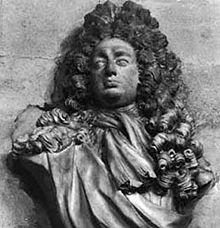David Gregory (mathematician)
David Gregory (born June 3, 1659 in Aberdeen , Scotland , † October 10, 1708 in Maidenhead , Berkshire , England ) was Professor of Mathematics at Edinburgh University and Professor of Astronomy at Oxford University . He was a commentator on the Philosophiae Naturalis Principia Mathematica by Isaac Newton .
Life
David Gregory was a nephew of the astronomer and mathematician James Gregory and the fourth of 15 children of a doctor who was a squire in Kinnairdy.
David Gregory probably went to school in Aberdeen and began studying at Marischal College, Aberdeen University in 1671 and studied until 1675. However, there is no evidence of graduation. Also in 1675, his uncle James Gregory died, and David Gregory began studying the mathematics inherited from his father. In 1679 he left Scotland and visited various countries on the continent. He studied medicine and the mathematical works of Johann Hudde , Pierre de Fermat and René Descartes in Leiden .
In 1681 he returned to Great Britain and attended the Royal Society in London, where he saw, among other things, Isaac Newton's reflecting telescope and Robert Boyle's air pump . He then studied again on the home estate in Scotland and in 1683 was appointed Professor of Mathematics at the University of Edinburgh, the same chair that his uncle held.
He taught geometry, optics, mechanics and hydrostatics in Edinburgh and was one of the first university teachers to spread the teachings of Newton in lectures. He entered into correspondence with Newton, to whom he sent a work on infinite series (and extensively praised him) and who in 1687 sent him a copy of the Principia. Probably the copy in Lomonosov University , with many annotations, and which came to Moscow in 1718 from the library of Archibald Pitcairne, who was a friend of Gregory.
In 1690 he left Scotland in times of political and religious turmoil (he was a member of the Scottish Episcopal Church, which belongs to the Anglican Church and in Scotland at that time the Presbyterians had been declared the official Church of Scotland) and moved to England, where he became Savilian in 1691 Professor of Astronomy at Oxford University. He owed this in large part to the influence of Isaac Newton. The Royal Astronomer John Flamsteed , who also had high hopes, received nothing. Flamsteed was at odds with Newton, and there was also the fact that he was not considered very religious, which was also true of Gregory. In the same year Gregory was appointed a Fellow of the Royal Society .
In 1695 he married. Again on the mediation of Newton, in 1699 he became the mathematics teacher of the young Duke of Gloucester (again in competition with Flamsteed), who would later become Queen Anne's son, but who died a year later. In 1704 he moved to London. Also on the mediation of Newton, he became head of the Scottish Mint after the personal union of England and Scotland in 1707 (a position Newton held in London) and took care of the introduction of English currency in Scotland. He also calculated the exact amount of compensation the Scottish Parliament received from Equivalent for taking over part of the UK's total national debt. Most recently he was plagued by diseases and died on the way back from a cure in Bath on the way to London.
He built an achromatic telescope and delved into mathematics education, where he advocated teaching in English and practical applications. In an essay published in 1697, Gregory derived the equation of the chain line with the help of Newton's fluxion calculus and, following Robert Hooke, determined that the inverted chain line was the true shape of a vault: With this he had determined the axis of a supporting line vault under its own weight for the first time. Gregory published a popular scientific account of Newton's astronomical theories in 1702 and supported Newton in a dispute with Gottfried Wilhelm Leibniz .
In 1703 he published a complete edition of Euclid's works in Oxford (Greek / Latin). He built on the preparatory work of his predecessor as Savilian Professor Edward Bernard (1638-1696), who had planned to bring out a complete edition of classical mathematicians, and by Henry Savile . This Oxford Euclid edition was considered one of the best editions before Johan Ludvig Heiberg in the 19th century. He was assisted by the librarian of the Bodleian Library John Hudson (1662-1719). However, the Greek text was largely based on the Basel edition of 1533.
family
In total, Gregory married twice. He is said to have fathered a total of 29 children. His firstborn, David Gregory , became the first Regius Professor of History at the University of Oxford. His sons James (1666–1742) and Charles (1681–1754) taught at the universities of Edinburgh and St. Andrews .
Fonts
- Exercitatio geometria de dimensione curvarum , 1684
- Catoptricae et dioptricae sphericae elementa , 1695
- Astronomiae physicae et geometricae elementa. 1702.
Its geometry lectures in Edinburgh included in the Treatise of practical geometry of Colin Maclaurin , a 1745th
Individual evidence
- ^ Karl-Eugen Kurrer : The History of the Theory of Structures. Searching for Equilibrium . Berlin: Ernst & Sohn 2018, pp. 226f., ISBN 978-3-433-03229-9 .
- ↑ a b c d Papers of the Gregory family of Aberdeen, Edinburgh, St Andrews and Oxford. Retrieved March 13, 2018 (52 boxes No physical characteristics affecting use of collection).
Web links
- John J. O'Connor, Edmund F. Robertson : David Gregory. In: MacTutor History of Mathematics archive .
| personal data | |
|---|---|
| SURNAME | Gregory, David |
| BRIEF DESCRIPTION | Scottish mathematician |
| DATE OF BIRTH | June 3, 1659 |
| PLACE OF BIRTH | Aberdeen , Scotland |
| DATE OF DEATH | October 10, 1708 |
| Place of death | Maidenhead , Berkshire , England |

